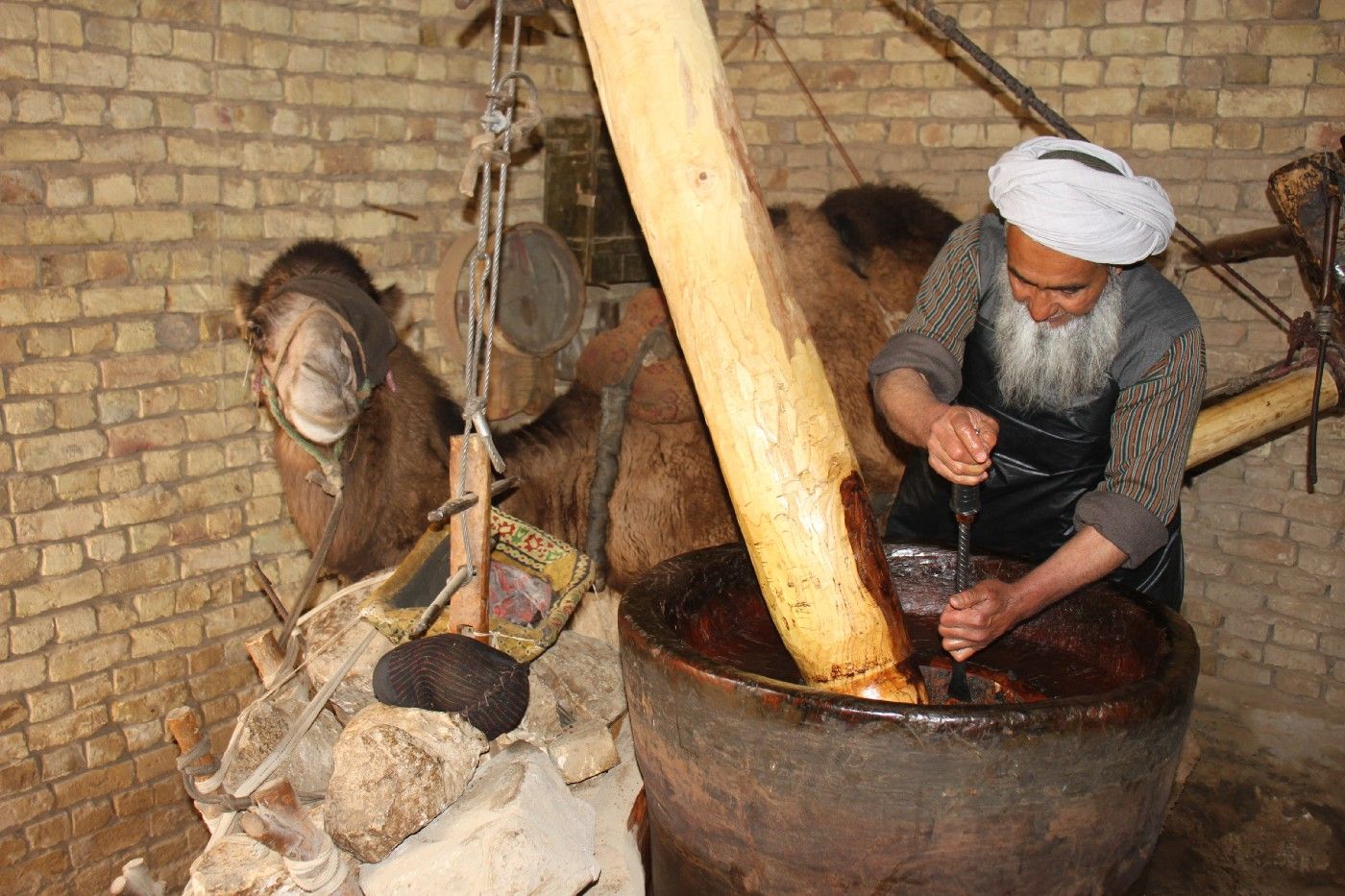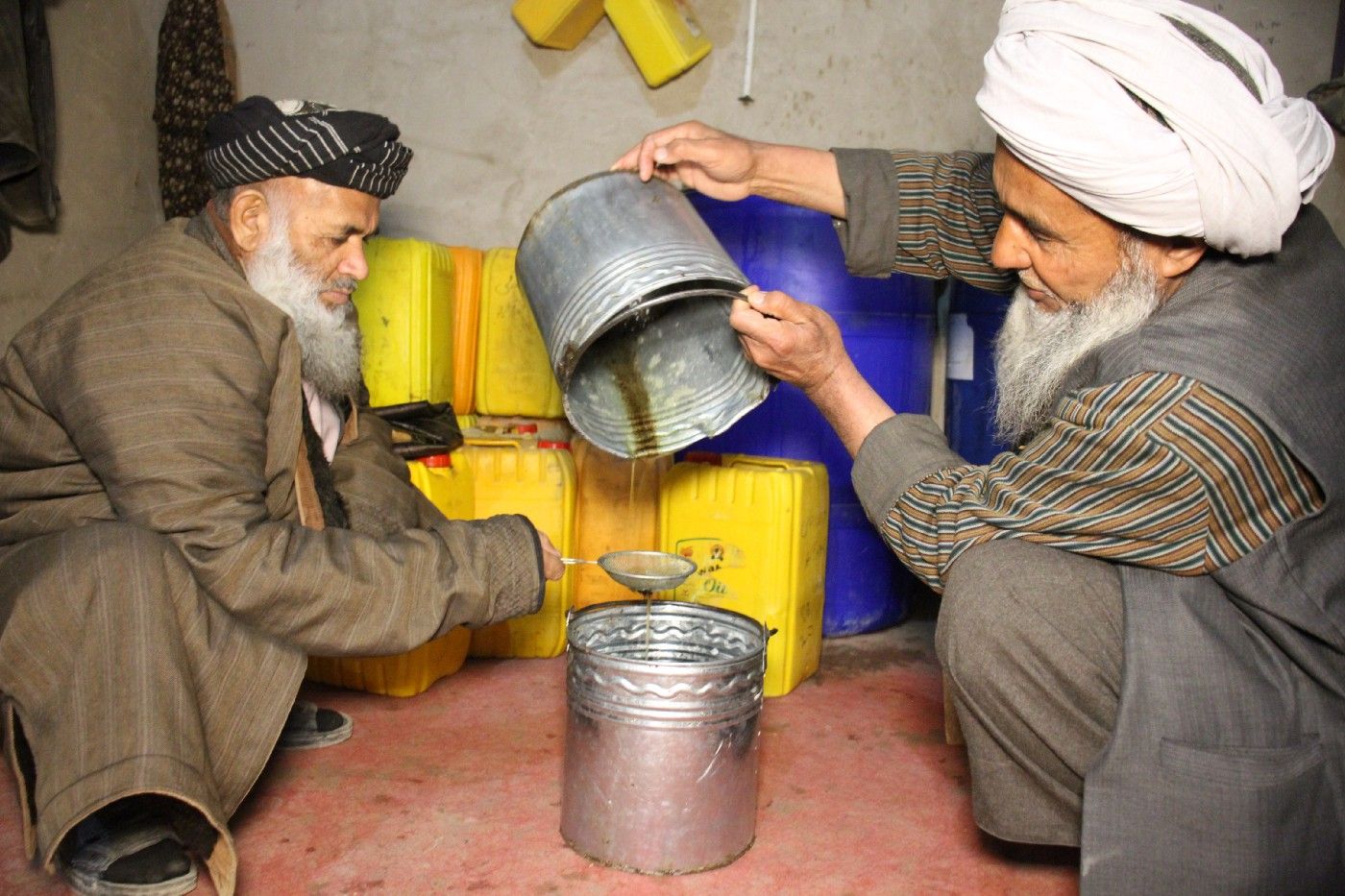Processing Cooking Oil the Old Way

Reporting By Qamaruddin Poya Aziz, written by Abdul Ahad Poya and Mohammad J. Alizada, edited by Brian J. Conley
62 year-old Mohammad Ishaq takes an empty glass, pours some oil into it from a large blue barrel with a steel cup and drinks it, in a don’t do this at home manner. He says, “I am used to this, I don’t want any brothers to drink this and get ill.”
Ishaq, who is a cooking oil producer in Afghanistan’s northern Jawzjan province, has been producing oil, mainly sesame, using this traditional method for the past 38 years and feeds a family of 12 with the money he earns from this business.
I get to Ishaq’s house located in Mirwais Mina area on the outskirts of Sheberghan, the capital of Jawzjan province, after walking through several alleys at about 8:30. He gives me a warm welcome by shaking my hand, his hand full of blister marks and rough from working so many years in the business.
Ishaq is a native of Du Koh district, but he left his hometown some 8 years ago to seek new opportunities. Although he has 10 kids and a number of his sons are earning incomes, his pride does not allow him to sit idly.
Mohammad Ismail, Mohammad Ayoub and Mohammad Arif are three of Ishaq’s oldest kids who finished high school but discontinued higher education due to the family’s economic situation and instead headed to Iran for work.
Most Afghans who travel to Iran for work do manual labor and send home the money they earn to keep their family fed. They don’t see their families for years in some cases. Mohammad Hanif and Mohammad Yousof have graduated high school while Mohammad Asif and Mohammad Haroon are in 11th and 9th grade respectively.
Hanif and Yousof have opened a tire repair shop, fixing flat tires while Asif and Haroon help their brothers after school. Ishaq does not share information about his daughters due to the stigma of talking about women.
Ishaq who owns the business and runs it out of his private home on average earns about 1,300 Afghanis ($13.50) per day. He also sells the sesame leftovers. The remnants provide a nourishing meal for animals, especially those that produce milk.
The value of the Afghani against the dollar has dropped significantly. Afghanis were exchanged at 75 Afghanis to $1 just before the collapse. Now the exchange rate has fallen to 96 Afghanis to $1, a nearly thirty percent drop in value.

56 year-old Juma Guldi, works for Ishaq for 300 Afghanis ($3.13) per day. Juma, who has a family of seven, has been working with Ishaq for the past four months.
We enter the 6 by 6 meter room that works as the oil producing workshop in the corner of Ishaq’s house. Another small room adjacent to this one serves as the store for selling the oil, which has a door to the street.
Ishaq’s workshop consists of a blindfolded camel with rope tied to the back that turns a piece of wood within a large bowl that they fill with sesame. As the camel moves around the bowl in order to crush the sesame seeds, a block of wood with a thickness of 6 inches, with one end inside the second layer of the bowl and another end inclined in the air is tied to a rope that attaches to another wooden device, which carries the rocks. The rocks are on a piece of wood that is attached to the camel so when it turns in a circle, one end of the piece of wood turns inside the bowl, crushing the seeds.
“The weight of the rocks is about 500 kg so it can turn with the camel and put enough pressure on the piece of wood and the seeds for producing the oil,” Juma tells Alive in Afghanistan.
The camel is blindfolded so it doesn’t get dizzy or lightheaded while turning in circles.
It’s now 9:30 am. Ishaq and Juma have already filled the large bowl with sesame.
“We clean the sesame before putting it into the bowl,” Ishaq says.
Juma signals the camel by pulling its leash and the camel starts moving without any resistance, like the animal has been doing this for years.
Juma explains the design and function of the bowl.
“The inside of the tube, the bowl, has three layers. The top layer is for putting the sesame seeds in, the middle layer is for crushing the sesame and producing the oil, and the bottom layer serves as a storage and transferring the oil to the bucket below.
While feeding the sesame to the opening the camel turns the big block of wood around that crushes the sesame to produce the oil, Juma says, “I have been doing this for nearly 40 years and I am happy with my job.”
A small hole below the bowl is the opening for the oil dripping in the bucket after going through a special cloth that serves as a filter. The camel continues walking in circles for about an hour and Ishaq keeps feeding the seeds back into the tube so it can produce as much oil as possible.
After all the sesame is crushed, they take another hour of turning the camel in circles to make sure that all the remaining oil inside the sesame leftover is forced out, then they stop. Juma takes the bucket to one side of the room and picks up a flat headed piece of metal. He digs out the sesame leftovers from the bowl and puts it in another bucket.
It has taken nearly 2 and a half hours to complete this process but time has gone by fast since I am very engrossed in the process and my interest has peaked with a profession I was not familiar with prior to today.
“I need to add about 1.5 liters of water to every 14 kg of sesame seeds so the seeds stick together and don’t escape while being crushed,” Ishaq says, adding that it takes over two hours to take out the oil from 14 kgs of sesame.
According to Ishaq, they only use a colander for filtering the oil, no chemicals.

The work process is so interesting that I forget about the time. It’s now 12 pm and Ishaq has other guests, his neighbors, who have come to watch me film and take shots of his work. It’s like Ishaq already knew what my favorite meal is. We are served Konjid Palaw, an Afghan delicacy made out of rice and lamb with the sesame oil he produces. While eating, Ishaq explains that this is a family business he has inherited from his grandfather. His grandfather started the business about 100 years ago.
It’s now 2 pm and we are back to work after lunch and prayers. This time they tie Juma’s camel to the rope, blindfold it and signal it to circle the bowl. The same process is repeated and after a couple of hours, we have another bowl of sesame crushed.
“I grow some of the sesame myself but a large portion of it is bought from other people,” Ishaq says.
According to Ishaq, who has a lifelong experience in producing sesame oil, the best sesame is grown in Sancharak district of northern Sar-e Pul province.
“The sesame from Sancharak district is the best in the entire country,” Ishaq adds.
Ishaq says he sells a kilo of sesame oil for 250 to 280 Afghanis ($2.60 to $2.91) in the market but it is sold for up to 850 ($8.84) per kilo in big cities and outside of Afghanistan.
“Sesame is both rain fed and water fed, rain fed sesame produces more oil. 14 kilos of rain fed sesame produces about 7 kilos of oil while the same amount of water fed sesame produces a lot less oil,” Ishaq tells me.
Ishaq says his secret to staying healthy is drinking a glass of sesame oil every day, he has done that every day in the past 38 years. He believes the oil treats a lot of illnesses in the body and saves him from visiting the doctor.
The oil that Ishaq produces is sold throughout Afghanistan, especially in southern Kandahar province and sometimes exported to countries abroad. However, Ishaq’s business has been affected by the recent developments in Afghanistan as well. Due to high rates of unemployment, limitations on cash and the downturn of the economic situation, the amount of oil Ishaq sells has also decreased.
“People either don’t have money or it is stuck at a bank,” Ishaq says.
Ishaq says his sales have had a 30 percent downward trajectory since the year before. The amount of oil he produces has also been slashed in half compared to last year.
Ishaq’s business has survived through the past 40 years of conflict in Afghanistan, although the business is not doing as good as the year before, the man doesn’t look that concerned and seems ready to fight on whatever comes his way.
